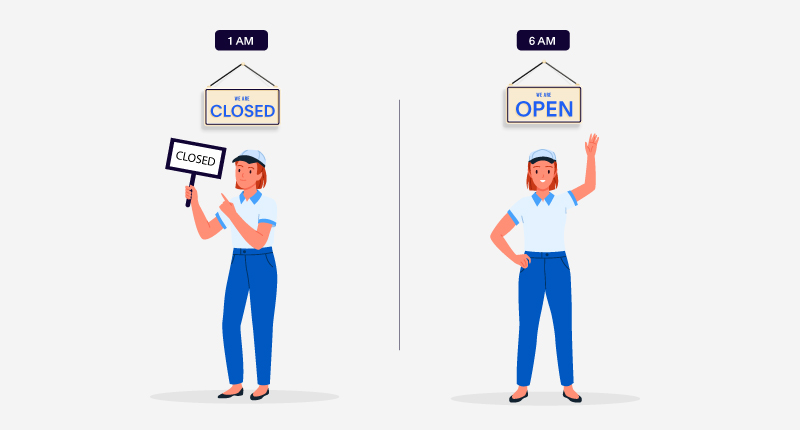What Is a Clopening Shift and What Are Clopening Laws?

The clopening shift is when an employee who closes the business at night is responsible for opening it after a few hours of rest. Businesses use clopening shifts voluntarily or involuntarily for various reasons. However, many US states are restricting its excessive practice to keep the law of ‘right to rest’ intact.
This guide discusses how the clopening shift works, the downsides of Clopening shifts, and how the clopening laws minimize its practice & in which states.
What Is a Clopening Shift?
The word ‘Clopen’ is derived from a combination of two words – closing and opening. Clopening shift is when an employee who closes the business at night is also responsible for opening it again the very next day.
It’s the practice in which the worker who works the closing shift returns a few hours later to work the opening shift.
Clopening shifts are discouraged because of the fact that workers get very little time to rest between closing and opening shifts, which can be as few as 4 hours. In clopens, employees work till late at night, commute back home, and then start work early in the morning, due to which they don’t get sufficient time to rest and recharge.
This inadequate sleep impacts workers’ mental and physical health, leading to dissatisfaction, increased burnout, and higher turnover.
Clopens are frequent in businesses that have a shortage of staff or have a few workers who are accountable for opening and closing the business.

Examples of Clopening Shift
Here are a few ways employees work a clopening shift in different industries:
- A retail store manager closes the store at midnight and again opens it at 5:30 a.m.
- A restaurant worker closes the restaurant at 1 a.m. and arrives early the next morning to open the restaurant at 8 a.m.
- During the busy months or festive season, a worker closes the store at 1 a.m. and again opens the store at 7 a.m. to entertain maximum customers’ requests.
- A worker closes the bar at 2 a.m. and the next morning opens it for business again at 7 a.m.
| Closing Shift | Opening Shift | Rest Time between two shifts |
| 12 AM | 6 AM | 6 hours |
| 2 AM | 7 AM | 5 hours |
| 2 AM | 6 AM | 4 hours |
Industries Where Clopening Shift Is Common
Clopening shifts are common in retail, hospitality, and food industries that require operation for extended hours or even 24 hours. Specifically, businesses that close briefly during the night and start early in the morning use this shift more often.
Here are the businesses where Clopens are frequently assigned:
|
Negative Effects of Clopening Shifts
Sleep Deprivation and Other Health Issues
One of the major downsides of Clopens is that workers don’t get sufficient sleep, as there’s a limited rest period between the two back-to-back shifts.
As per a CDC report, an adult requires at least 7 hours of slumber daily to function properly. Workers who don’t get adequate sleep are prone to mental and physical health issues, such as mood swings, lack of concentration, stress, etc.
In addition, repeated sleep deprivation for a longer period can result in chronic health issues, such as diabetes, stroke, heart disease, obesity, and high blood pressure.
Impact on Productivity and Performance
A survey conducted by Ceridian LifeWorks has revealed, “Around 30% of HR have witnessed their co-workers falling asleep at the workplace, and more than 35% of respondents in a survey revealed that sleep deficiency had a negative impact on their productivity”.
When employees work in clopening shifts consistently, it can degrade their productivity and performance. That’s because workers hardly get sufficient rest after work, which may result in them committing more mistakes at work, decreased productivity, and increased chances of workplace accidents.

Employee Dissatisfaction and Increased Employee Turnover
An inadequate rest period and extended shift work in a Clopen can take a toll on workers’ mental health and impact their work-life balance. It can overwhelm them and increase the chances of burnout, fatigue, and stress. This is why employees who consistently do Clopens are more likely to quit their jobs, increasing the organization’s turnover rates.
In addition, as per a Gallup survey, workers who didn’t get enough sleep reported to have changed their jobs in the past 12 months. Sleep quality is indirectly related to the employee turnover rate, and this statistic sheds light on this fact.
According to it, organizations where employees don’t get quality sleep experience a very high turnover rate of 27%.
| Sleep Quality | Turnover Rate (%) | Total Full-time Workers (in millions) |
| Excellent sleep | 16 | 35 |
| Good sleep | 19 | 52 |
| Fair sleep | 22 | 32 |
| Poor sleep | 27 | 10 |
Challenges in Finding Childcare Services
Due to the shift work that extends till late at night and starts early in the morning, parents may face difficulty in finding childcare services for their children. To sort this out, they’ll need to rely on their family members or they should be able to afford an expensive babysitter who can look after their kids for a long period of time.
Poor Job Performance and Low Morale
Employees need some time to rest and recover from the exhaustion of the last shift before they start their next work shift. However, Clopens don’t provide enough rest periods to employees, making them unfocused and tired. In this condition, they may struggle to work productively and show any enthusiasm at the workplace.
On top of that, employees who work on the customer-facing side may not be able to provide a good customer experience when sleep impaired, resulting in the loss of valuable customers.
Due to all of these reasons, clopening can create the problem of attrition, causing staff shortage – the very issue that employers try to deal with when they use this shift.
Reasons Why Businesses Opt For Clopening Shifts
Staff Shortage
Clopening becomes inevitable when a manager lacks the resources to split into different shifts. That’s why businesses with a shortage of staff use Clopen more frequently.
In addition, it’s implemented when some workers are on time off. In that case, others will have to pick up the slack by working in Clopens to keep business operations uninterrupted.
Inexperienced Managers
Sometimes, Clopens can happen even when there are ample resources to distribute among multiple shifts. However, in such cases, it’s due to an oversight on the part of the managers who assign back-to-back shifts to employees without checking any conflicts and Clopens.
Managers can create such schedules voluntarily or involuntarily. There can be two cases when managers create such clopening shifts-
- They don’t have sufficient resources to distribute into multiple shifts to ensure coverage for an extended period.
- They can create such schedules mistakenly because they may not be aware of the best scheduling practices. Or they don’t have the appropriate tools to get visibility into resources and schedules to check the possibility of such conflicts.
The chances of such errors increase when managers create schedules manually. However, the problem can be eliminated by empowering managers with efficient scheduling software.
Miscommunication Between Multiple Managers
Clopening can also happen when an employer has multiple managers to supervise work during different parts of the day. For example, if there are different managers for day and night shifts, and if they both assign resources for their respective shifts without communicating with each other, then it’s likely to create a Clopen for some employees.
Cost Cutting
Businesses that are looking for ways to cut costs or lack the budget to hire new employees find Clopens to be the best substitute for their shift coverage requirements.
These businesses take a stab at reducing costs by utilizing the same resources for stretched work hours instead of spending on hiring new employees. They also want to avoid the costs of onboarding, background checking, and training.

Limited Trusted Employees
When a business keeps hiring new employees every now and then or has a high turnover rate, the employers are left with only a few trusted employees who have experience in closing and opening the business. That means only a few employees will be responsible for opening and closing the business, due to which they may frequently be a part of Clopens.
How to Avoid Clopening Shifts
Create a Schedule in Advance
It’s recommended to create a schedule and notify employees in advance so that employees can report the occurrence of any clopening shift to their managers before it’s too late. In fact, many states in the U.S. have adopted predictive scheduling laws that require employers to notify their employees about their respective schedules in advance. These laws were introduced to limit on-call scheduling, which severely disturbs any employee’s work-life balance due to sudden changes in shift timings.
In case a Clopen is unavoidable, the pre-notice can at least help employees get prepared for such shifts as they can try to manage childcare for their children or adjust any major personal commitments.
Consider Employee Feedback
The best way to understand how employees feel about any shift is to conduct a survey. Ask your employees for their feedback anonymously and gauge their responses. In the survey, you can ask questions such as:
- How do you feel about working in Clopens?
- What do you like and dislike about Clopens?
- Are you comfortable with occasional clopenings?
- Can you work in clopening shifts if certain benefits or perks are offered?
Though a clopening shift is the least preferred schedule for most employees, some workers may be comfortable with occasional clopening shifts. Thus, this survey can reveal workers who find this shift too hectic and those who can occasionally work in Clopens. This insight will help you make informed decisions on resource management and create an effective schedule for employees.
Hire Additional Employees
The best way to avoid the Clopens is to hire more employees who can be split into multiple shifts so that the responsibility of opening and closing the shifts can be distributed evenly.
But what if the budget doesn’t allow you to hire as many employees as needed?
You can consider hiring one or two backup employees to avoid back-to-back shifts.
Also, make sure to train the new hires to handle the job of opening and closing, as some businesses tend to rely on a few trusted employees to perform this duty, leading to clopening shifts.
You can document the process of opening and closing the shift and make it a part of the mandatory training process for all new hires. You can even create a checklist for employees so they don’t make any mistakes while closing/opening the shift.
Provide Flexibility to Swap Shifts
Clopens can be avoided by allowing workers to swap their shifts with co-workers. This flexibility gives them a sense of control over their lives and helps them restore their work-life balance. Employees can ask their co-workers if they are willing to trade shifts to avoid working in Clopen.
For example, if worker-A has a clopening shift for June 2 and worker-B has a clopening shift for June 6, then worker-A can swap the closing shift with the opening shift of worker-B, and vice versa. This way, both can avoid their clopening shifts with proper communication and swapping.

Set Mandatory Rules
Even if your employees have to work the clopening shift occasionally, it’s your responsibility to make sure that they take the necessary rest between these back-to-back shifts. You can set mandatory rest hours to be provided between the two shifts. You can also compensate for clopening shifts by providing overtime pay, extra perks, or benefits such as time off in lieu.
Thus, using any efficient scheduling software such as Workforce Management Software from Replicon, you can:
- Create conflict-free shifts
- Flag the occurrence of Clopen and scheduling errors
- Save your time and energy
- Notify workers about their shifts in advance
- Ensure balanced distribution of shifts for employees
- Get notified about shift swapping requests from workers
You can also configure the software to tailor your specific requirements, such as setting a mandatory break limit of 7 hours between two shifts to mitigate the effect of a Clopen. Moreover, effective scheduling software keeps track of scheduling laws of specific regions, thus helping employers stay compliant and mitigate the risk of heavy penalties and litigation.
Is Clopening Illegal?
Clopening is not illegal, but many states have imposed some restrictions and regulations to minimize its practices. On the other hand, some well-known brands had to take proactive steps to reduce the practice of clopening shifts to save their public reputation.
For instance, some states require a specific rest period between two shifts on a mandatory basis. And, if an employer asks employees to work in clopening shifts, then it’s mandatory to pay them extra as compensation. Many refer to this pay as ‘right to rest’ or ‘clopening’ pay.
What Are Clopening Laws?
Clopening laws are made to restrict employers from scheduling clopening shifts and protect employees’ right to rest by imposing mandatory breaks between two shifts. Many cities and states in the U.S. are embracing predictive scheduling laws to reduce the cases of clopening shifts.
For instance, Oregon, Chicago, Philadelphia, New York City, California, and Seattle have adopted predictive scheduling laws for certain industries that require employers to provide advance notice of scheduling. Here, employees must be compensated for last-minute alterations in the schedule. Some state laws also require that employees working shifts that are less than 11 hours apart from each other are entitled to time and a half pay.
Different states have laws for Clopen, which can also be specific to certain business or industry types. It’s crucial to check the state’s official source to stay compliant with these local clopening laws.
Here Are a Few Examples of Scheduling Laws in Different States and Cities in the US
- In New York City, specifically in the food industry, employers can’t schedule back-to-back shifts with less than 11 hours of resting period between two shifts. If an employee agrees to work in Clopen with written consent, the employers must pay such workers a $100 premium to compensate for it. Moreover, the workers have the right to refuse to work the clopening shifts.
- In Oregon, employers need to provide at least 10 hours of gap between back-to-back shifts unless the worker agrees. Even if the worker does the clopening shift, they must be paid time and a half for their work hours.
- In Chicago, employees have the right to refuse to work shifts scheduled within 10 hours of each other. If they work this shift, employers must pay them 1.25 times their regular pay rate.
- In Seattle, employees, specifically those working in retail and food industries, are entitled to get paid at the rate of time and a half for working in the clopening shifts, if scheduled within 10 hours of each other.
- In Philadelphia, employers need to provide a minimum of nine hours of rest period between two consecutive shifts. But, if an employee agrees to work a clopening shift, the employer must compensate it with $40 per clopening shift. This rule is especially applicable to retail, food and hospitality industries.
- In Emeryville, California, employers need to provide a minimum rest period of 11 hours before the next shift starts. If they don’t provide this rest period, they’ll have to compensate for it by paying at the rate of one and a half.
- In Los Angeles City, the law covers certain retail businesses, according to which employers can’t schedule two back-to-back shifts with less than 10 hours of gap in between. Even if they do, they need to have the employee’s written consent and must pay employees the premium pay of time and a half for hours worked in the second shift.
Bottom Line
Clopening is likely to happen with hiring issues or issues with the management of the workforce. That’s why businesses should use best scheduling practices to avoid Clopens and provide better work-life balance to employees.
But if a clopening shift becomes unavoidable and workers agree to work this shift, employers should ensure they stay abreast of the city/state laws to stay compliant and avoid penalties or litigations.
FAQs
Is clopening legal?
Clopening is not illegal, but many states and cities have adopted predictive scheduling laws that restrict the practice of Clopen and use certain guidelines in case an employer uses the Clopens for their employees.






